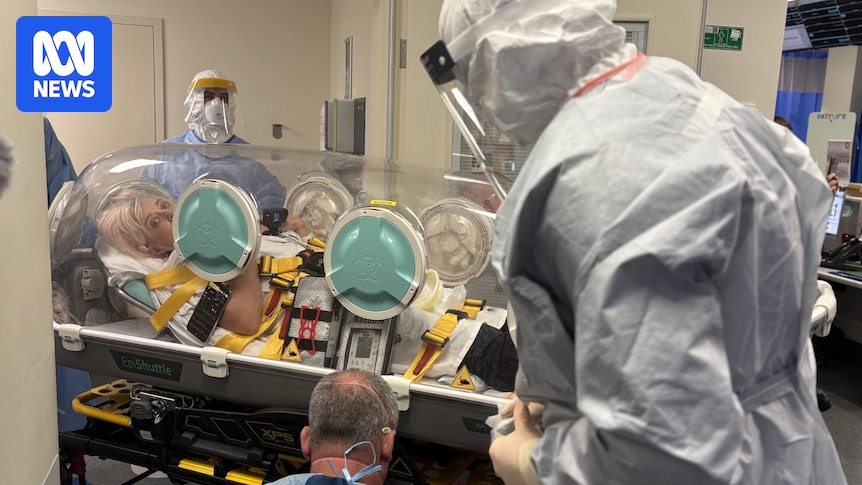In a quarantine room at Concord Hospital in Sydney’s inner west, a high-stakes mission is underway.
A returned traveller showing symptoms of the potentially deadly Ebola virus is being strapped into a bio-containment bubble on a stretcher.
Before the lid is sealed, specialist paramedics and doctors check her oxygen and water supply.
Her heart rate and temperature will be monitored as she is transported to Westmead Hospital to be treated for a high-risk infectious disease.
Multiple agencies are involved in this delicate response to a potentially dangerous situation — but thankfully, the emergency is not real.
The bio-containment bubble at the hospital was put to good use in this practice scenario. (ABC News: Fiona Willan)
Hospital tests emergency response plans
Sydney Local Health District disaster manager Caren Friend said the practice run-through was a multi-agency exercise aimed at testing emergency response plans.
“Firstly, to make sure we’re prepared … and our staff are current in their knowledge,” she said.
“But also to make sure we’re doing the right thing — it gives us a little bit of peace of mind as well.”
The exercise started when the woman walked into Concord Hospital’s emergency room on Friday morning and told the triage nurse she had fever, aches, pains and bleeding gums.
The multi-agency exercise is aimed at testing emergency response plans. (ABC News: Fiona Willan)
But another detail caught the attention of the nurse.
The 38-year-old woman revealed she had recently returned from Sierra Leone.
With a current Ebola outbreak in Africa, this information was enough to trigger the hospital’s high-risk emergency response plan.
The worker quickly took steps to safeguard herself in protective gear, including a face shield.
Protective gear, including a face shield, is crucial for healthworkers dealing with potential Ebola cases. (ABC News: Fiona Willan)
As a red alert was played over the loudspeaker, the patient was escorted to a quarantine room.
She paused on the way to warn she was feeling nauseous, before emptying a container of rice pudding on the ground.
This was another important part of the test — as the Ebola virus is spread through bodily fluids such as vomit and blood.
Staff quickly moved to clean up the mess, as the woman underwent a medical assessment in isolation.
The run-through helps to ensure staff are current in their knowledge of highly-infectious diseases. (ABC News: Fiona Willan)
‘We must be prepared’
Ms Friend said the exercise was not about testing individual performance, but to ensure response plans were effective.
Communication was another key part of the response.
In the hospital’s incident control room, key decision makers held talks with multiple government agencies to plan the next steps.
Timothy Gray from Concord Hospital’s Infectious Diseases Department described the patient’s symptoms and travel history to paramedics and staff at the NSW Biocontainment Unit at Westmead Hospital.
It was agreed she should be transferred there for treatment.
Dr Gray said the timing of the exercise was important due to the current outbreak of Ebola in central Africa.
“Australia hasn’t had any Ebola or Ebola-like illnesses imported yet — but cases have been imported [in the past] to America and also into Europe as well,” he said.
“So we must be prepared for the event it occurs here.”
Similar drills were held this week at Royal Prince Alfred Hospital, Canterbury Hospital and Balmain.

